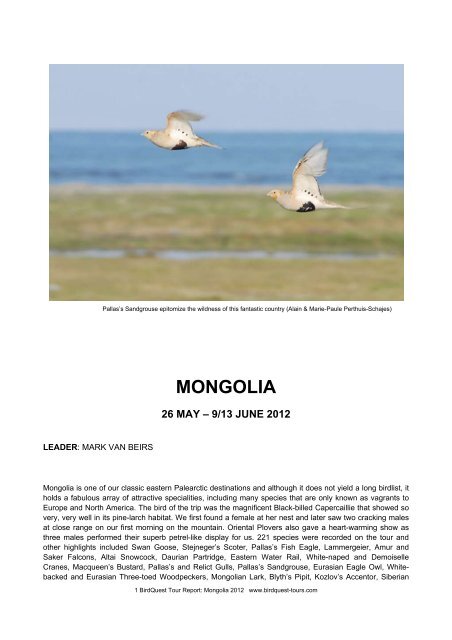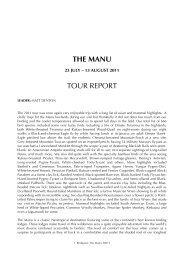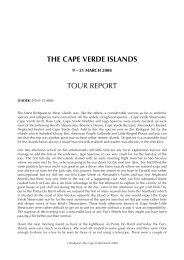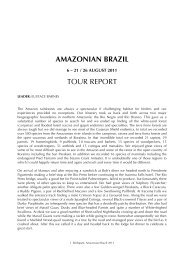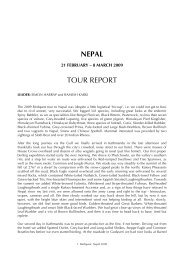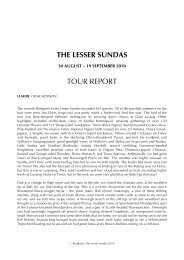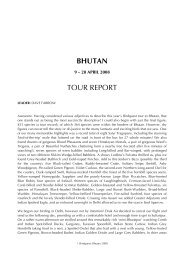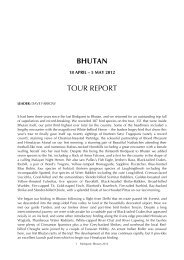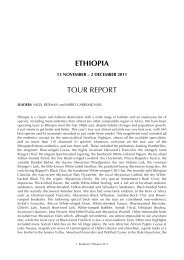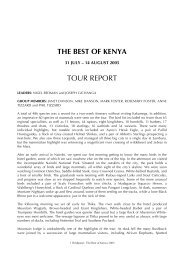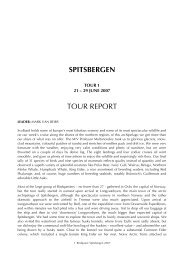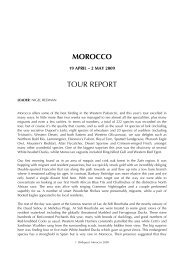MONGOLIA REP 12 - Birdquest
MONGOLIA REP 12 - Birdquest
MONGOLIA REP 12 - Birdquest
You also want an ePaper? Increase the reach of your titles
YUMPU automatically turns print PDFs into web optimized ePapers that Google loves.
LEADER: MARK VAN BEIRS<br />
Pallas’s Sandgrouse epitomize the wildness of this fantastic country (Alain & Marie-Paule Perthuis-Schajes)<br />
<strong>MONGOLIA</strong><br />
26 MAY – 9/13 JUNE 20<strong>12</strong><br />
Mongolia is one of our classic eastern Palearctic destinations and although it does not yield a long birdlist, it<br />
holds a fabulous array of attractive specialities, including many species that are only known as vagrants to<br />
Europe and North America. The bird of the trip was the magnificent Black-billed Capercaillie that showed so<br />
very, very well in its pine-larch habitat. We first found a female at her nest and later saw two cracking males<br />
at close range on our first morning on the mountain. Oriental Plovers also gave a heart-warming show as<br />
three males performed their superb petrel-like display for us. 221 species were recorded on the tour and<br />
other highlights included Swan Goose, Stejneger’s Scoter, Pallas’s Fish Eagle, Lammergeier, Amur and<br />
Saker Falcons, Altai Snowcock, Daurian Partridge, Eastern Water Rail, White-naped and Demoiselle<br />
Cranes, Macqueen’s Bustard, Pallas’s and Relict Gulls, Pallas’s Sandgrouse, Eurasian Eagle Owl, Whitebacked<br />
and Eurasian Three-toed Woodpeckers, Mongolian Lark, Blyth’s Pipit, Kozlov’s Accentor, Siberian<br />
1 BirdQuest Tour Report: Mongolia 20<strong>12</strong> www.birdquest-tours.com
Rubythroat, Güldenstädt’s and Eversmann’s Redstarts, Hodgson’s Bushchat, Pallas’s Grasshopper,<br />
Lanceolated and Asian Desert Warblers, Azure and White-crowned Penduline Tits, Henderson’s Ground<br />
Jay, Saxaul Sparrow, Asian Rosy Finch and Pine, Meadow, Grey-necked, Yellow-breasted and Pallas’s<br />
Reed Buntings. Interesting mammals included Corsac Fox, Mongolian Gazelle and Przevalski’s Horse.<br />
Camping is the only way to discover the real Mongolia, as there are no hotels or ger camps away from the<br />
well-known tourist haunts. Our camping crew did a terrific job and provided tasty food and more than<br />
adequate facilities. Travelling in Mongolia is a fantastic experience as the scenery is some of the best in the<br />
world. We wandered for 19 days through the wide and wild steppes, deserts and semi-deserts, mountains,<br />
marshes and taiga of this thinly-populated country. The unfamiliar feeling of ‘space’ charged our batteries<br />
and we experienced both icy cold and rather hot circumstances.<br />
A lovely flight in very clear weather took us from various cities in Europe to Moscow and allowed us to<br />
admire broad meandering rivers, enormous bright yellow rapeseed fields and small towns. The onward flight<br />
to Ulaanbaatar was during the dark hours and early in the morning we landed at Mongolia’s international<br />
airport just outside the capital. After a bit of a rest and an excellent lunch, we explored the willow and poplar<br />
groves along the Tuul river at the edge of the sprawling capital. Traffic had increased even more since my<br />
last visit and as it was also a local holiday, lots of people were enjoying the fine weather. It didn’t take long to<br />
locate the endearing Azure and White-crowned Penduline Tits in the riverine vegetation. We obtained great<br />
views of these jewels and also observed Black Stork, Ruddy Shelduck, Black-eared Kite, Eurasian Black<br />
Vulture, Goosander, Eurasian Hobby, Common Tern, Common Cuckoo, Fork-tailed Swift, Eurasian Hoopoe,<br />
Olive-backed Pipit, Grey and Baikal Wagtails, Lesser Whitethroat, Arctic Warbler, Great Tit, Brown Shrike,<br />
Eurasian Magpie, Eastern Crow and Rook, Daurian Jackdaw, Red-billed Chough, Common Raven and<br />
Common Rosefinch. A great introduction to Mongolian birding!<br />
A smart Eurasian Red Squirrel and an Eurasian Nuthatch at its nest (Alain & Marie-Paule Perthuis-Schajes)<br />
Next morning, due to a flat tyre, we first walked about in an area of steppe on the outskirts of Ulaanbaatar,<br />
where Isabelline and Northern Wheatears, a male Amur Falcon, Common Kestrel, Demoiselle Crane,<br />
Horned Lark and Tarbagan Marmot showed. In a scrubby, rocky valley of the Bogd Khan National Park we<br />
found Black Woodpecker, Pied Wheatear, Meadow Bunting and Long-tailed Ground Squirrel. A pine covered<br />
slope bordering a valley dotted with birches and willows gave us Eurasian Nuthatch at its nest, Willow Tit,<br />
Dark-sided Flycatcher, Black-faced Bunting and a smart, totally black Eurasian Red Squirrel. In mid<br />
afternoon we boarded a flight south to the Gobi, where three sturdy Russian minibuses waited for us. We<br />
stocked up on drinks and drove the short distance to our ger camp at the base of the Gobi Altai mountains,<br />
accompanied by several Pallas’s Sandgrouse and Asian Short-toed Larks.<br />
After the exciting experience of sleeping in a Mongolian ger, we visited the spectacular settings of the scenic<br />
Gurvansaikhan National Park. We first concentrated on the rolling rocky hills and climbed a steep junipercovered<br />
hill slope from where the fantastic, very picturesque surroundings could be appreciated. Sadly, upon<br />
arriving at the top cloud blocked our view, but on the way down the veil lifted and we soon found a couple of<br />
Altai Snowcocks walking about, allowing for great looks. They showed off a bit of display and the male could<br />
be seen uttering its distinctive calls. Great stuff! We also noted Brown and endemic Kozlov’s Accentors,<br />
2 BirdQuest Tour Report: Mongolia 20<strong>12</strong> www.birdquest-tours.com
Water Pipit, White-winged Snowfinch and a couple of fickle Argali. We then visited the gorge area of Yolyn<br />
Am, the Valley of the Lammergeier, where along the partly frozen stream amongst the steep rock faces and<br />
scree slopes we encountered lots of bird activity. Green Sandpiper, Eastern Grey-headed Wagtail, Black<br />
Redstart (of a red-bellied race), Twite, Mongolian Finch, Chinese Beautiful Rosefinch and Black-faced,<br />
Godlewski’s, Little and Ortolan Buntings vied for attention. Cute Pallas’s Pikas were everywhere and<br />
overhead we noted Lammergeier, Himalayan Griffon and Eurasian Black Vultures, Eurasian Sparrowhawk<br />
and Eurasian Crag Martin. Our lunch at the ger camp was interrupted by Steppe Eagle, Rufous-tailed Rock<br />
Thrush and Asian Brown Flycatcher and later we started driving west across gravelly plains and undulating<br />
foothills into the real wilds of Mongolia. A couple of unique Henderson’s Ground Jays performed beautifully<br />
and we also saw our first dashing Saker Falcon. In late afternoon we arrived at another ger camp, where we<br />
enjoyed excellent food and hot showers.<br />
Soon after dawn we were admiring the enormous and magnificent barchan (sickle) dunes of Khongoryn Els<br />
in beautiful early morning light. In a patch of gnarled saxaul bushes (Haloxylon ammodendron –<br />
Amaranthaceae) we soon encountered several pretty Saxaul Sparrows showing off at their nests. We also<br />
saw Isabelline and Steppe Grey Shrikes, Little Ringed Plover, Pallas’s Sandgrouse uttering their lovely calls,<br />
a pair of Upland Buzzards at their eyrie in a low bush, Northern Lapwing, Asian Short-toed Lark, Desert<br />
Wheatear and Pallas’s Leaf Warbler.<br />
The magnificent barchan dunes of Khongoryn Els (Mark Van Beirs) and a Saxaul Sparrow (Alain & Marie-Paule Perthuis-Schajes)<br />
For the next ten days we roamed, often far away from civilization, the deserts, steppes, hills and mountains<br />
of southern central Mongolia, admired spectacular sunsets and dawns, watched jaw dropping mountain<br />
scenery more than hundred kilometres away, stood in awe at shimmering sand dunes of enormous<br />
proportions and enjoyed amazing vistas with no sign of human presence visible. We experienced some<br />
extreme weather, as we got chilled to the bone on several occasions and got roasted by a fierce sun on<br />
others. There are now very few places in the world where one can undergo this unique feeling of<br />
nothingness, remoteness and wildness while observing some of the rarest birds in the world. Our party was<br />
totally self-contained with a sturdy kitchen truck and three minibuses, manned by a knowledgeable<br />
trekmaster, three experienced drivers and two excellent cooks. The latter managed to provide us with three<br />
course lunches and four course dinners every day and we never ate the same dish twice! The drivers were<br />
regularly seen to dismantle their engines overnight and they did an admirable job. This is the only real way to<br />
explore this extraordinary country, and most of us enjoyed it very much.<br />
The wide expanses of desert and semi-desert of the Gobi extend over most of southern Mongolia, but hold<br />
relatively few bird targets. Our main bird here was the unfathomable Pallas’s Sandgrouse. This year, they<br />
were everywhere and on many occasions we were able to admire this baffling species at close range,<br />
allowing us detailed looks at their subtly soft colours and delicate markings. We even managed to study the<br />
feathered tarsi and in flight the spiky tail, pointed wings and purring call attracted lots of attention. We could<br />
only wonder about the mysterious westward eruptions of this much-wanted species. It took a while before we<br />
found the smart Oriental Plover this year. We couldn’t locate them at our favourite gravelly plain, but<br />
3 BirdQuest Tour Report: Mongolia 20<strong>12</strong> www.birdquest-tours.com
eventually three pairs showed extremely well on a nearby greener expanse of semi desert. The handsome<br />
males really showed off and the joint, unique petrel-like display flight of three males was one of the highlights<br />
of the tour. While searching for the plovers Janice found us a splendid Macqueen’s Bustard. In these sandy<br />
or stony wastes we also observed Greater Sand Plover, and several interesting reptiles like Toad-headed<br />
Agama, Gobi Racerunner and Kaspischer Even-fingered Gecko. We encountered lots of beautiful Camels<br />
almost looking like the really wild ones which only survive in the extreme southwest of the country.<br />
A displaying Oriental Plover and a pair of Pallas’s Sandgrouse on the deck (Alain & Marie-Paule Perthuis-Schajes)<br />
In desert areas with man-high bushes we several times bumped into the wacky Henderson’s Ground Jay, a<br />
member of one of the most sought after Palearctic bird genera. We studied this snazzy species as it perched<br />
on top of a bush or as it was running about in search of prey. In flight the white wing patches really drew our<br />
attention. Here too we had amazing eye-ball to eye-ball views of a singing Asian Desert Warbler with its pale<br />
eyes, rufous tail and yellow legs. A couple of immaculate Rose-coloured Starlings posed for us and the<br />
mammal department was represented by a large Great Gerbil.<br />
Several major mountain ranges like the Gobi Altai and the Khangai crisscross central Mongolia and by the<br />
end of May we found the hard to reach higher areas virtually snow free. Altai Snowcocks behaved very well<br />
on the barren slopes, but our main target in these little visited uplands was the rare Hodgson’s Bushchat.<br />
Although it is sometimes seen on its wintering grounds in the terai of India or Nepal, very, very few<br />
birdwatchers have ever observed it on its breeding grounds. After a bit of searching we were able to study<br />
two males and a female foraging in the rock-strewn alpine meadows. We saw the male utter its simple song<br />
from the top of a boulder or bush. A heart-warming experience. The rocky ridges, scree fields and meadows<br />
also held singing Brown and Altai Accentors and some superb Güldenstädt’s Redstarts. Hardy Brandt’s<br />
Rosefinches eked out a living at the edge of remaining snow patches. Lower down, on north facing slopes<br />
stretches of larch forest were found to hold Eversmann’s Redstart, but the birds remained rather distant. A<br />
small crag showing a big patch of whitewash gave away the location of a raptor’s eyrie and a closer look<br />
produced great views of an adult and a youngster Lammergeier on their huge stick nest. Northern Goshawk,<br />
formidable Saker Falcons, Chukar, Eurasian Eagle Owl, Pallas’s Grasshopper Warbler, Alpine Accentor,<br />
Rock Sparrow, lovely Mongolian Finches and Grey-necked Bunting favoured the warmer rocky slopes of the<br />
lower reaches. The alpine meadows were ablaze with lots of splendid flowers including anemones, pasque<br />
flowers, buttercups, louseworts, gentians, saxifrages, stonecrops, primroses, violets, etc. The biggest<br />
surprise of the tour was finding a pair of nest building Asian Rosy Finches at one of the high mountain<br />
passes. A scenic valley dotted with willows amongst larch covered slopes held Pine Bunting, a close<br />
Eversmann’s Redstart, Red-throated Thrush, Siberian Stonechat and several Dusky Warblers.<br />
4 BirdQuest Tour Report: Mongolia 20<strong>12</strong> www.birdquest-tours.com
Our camp in the Khangai mountains (Alain & Marie-Paule Perthuis-Schajes)<br />
Further north, on the famous steppes, which in the days of Genghis Khan produced the multitudes of fleet<br />
riding warriors and their hardy horses, we saw many Eurasian Black Vultures. Elegant Demoiselle Cranes<br />
were dotted over the extensive greens and could often be seen displaying. We encountered several large<br />
gatherings of non breeding birds, and one of these held a splendid White-naped Crane! Colonies of Longtailed<br />
Ground Squirrels were usually attended by unpretentious Père David’s Snowfinches and colourful<br />
Mongolian Larks hovered over the wide expanses singing their ebullient songs. Here and there we found<br />
Upland Buzzards perched above breeding cliffs. Once, we managed to observe a Corsac Fox cautiously in<br />
pursuit of prey.<br />
Mongolia is dotted with both fresh, brackish and salt water lakes and these proved to be the most productive<br />
habitat for wildlife. Sadly, during the past twenty years many of the lakes in central Mongolia have started to<br />
dry up, not only because of an ongoing drought, but mainly because a lot of the water has been piped away<br />
to be used in gold mining ventures. Both famous Orog Nuur and Boon Tsagaan Nuur have greatly suffered<br />
from this and are now only a shadow of their former self. It was great to see that this year Orog Nuur held<br />
more water than ever and a good variety of well-known species was noted, including Mute Swan (a REAL<br />
one and our only one of the tour!) Greylag Goose, Eurasian Wigeon, Common Shelduck, Gadwall, Northern<br />
Shoveler, Tufted Duck, Western Marsh Harrier, Common Crane, Coot, Northern Lapwing, Black-tailed<br />
Godwit, Redshank, Eurasian Skylark and Pale Martins, while Oriental Reed Warblers and Bearded<br />
Reedlings were singing away in the reedbeds. Best of all was an unexpected Greater Spotted Eagle.<br />
At celebrated Boon Tsagaan Nuur, put on the birding map through <strong>Birdquest</strong>’s first historical tour there in<br />
1989, birds were everywhere, but it was sad to see that the shoreline had receded even more since our last<br />
visit. Our productive stay produced Great Cormorant, Great Egret, good numbers of Swan Geese, two adult<br />
Pallas’s Fish Eagle, Grey Plover, Eurasian Whimbrel, Terek Sandpiper, a Red-necked Phalarope in breeding<br />
5 BirdQuest Tour Report: Mongolia 20<strong>12</strong> www.birdquest-tours.com
plumage, many handsome Pallas’s Gulls, scores of Mongolian Gulls, Little, Whiskered, Black and many<br />
Caspian Terns and a flourishing Pale Martin colony.<br />
At another large lake we were amazed by the sheer numbers of birds and during our afternoon and morning<br />
visit we amassed a long list including goodies like Great Crested and Horned Grebes, Whooper Swan, Swan<br />
Goose, Eurasian Spoonbill, Bar-headed Goose, Eurasian Teal, Garganey, Northern Pintail, Red-crested<br />
Pochard, Common Goldeneye, Black-winged Stilt, Pied Avocet, Kentish and Mongolian Plovers, Pacific<br />
Golden Plovers in breeding plumage, Little Stint, Curlew Sandpiper, Dunlin, Ruddy Turnstone, Common<br />
Snipe, several smart adult Relict Gulls, Gull-billed Tern, scores of magnificent White-winged Terns, Greater<br />
Short-toed Lark, Citrine Wagtail, a female Siberian Rubythroat, Daurian Redstart and a flighty White’s<br />
Thrush.<br />
On the more northern steppe lakes just south of the forest belt, we found a different avifauna. Highlights here<br />
were the extremely handsome Black-throated Divers, Black-necked and Horned Grebes (in the same scope<br />
view), the many extremely vocal Whooper Swans, the remarkable Stejneger’s Scoters, Eastern Water Rail,<br />
Marsh and Wood Sandpipers, many displaying Blyth’s Pipits and a smart male Pallas’s Reed Bunting.<br />
Brandt’s Voles were swarming all over the place, behaving like lemmings and we even saw them swimming<br />
in the lake. The resident Upland Buzzards and Steppe Eagles were feasting.<br />
A pair of Whooper Swans with chicks (Alain & Marie-Paule Perthuis-Schajes)<br />
Villages or towns, consisting of communist grey, concrete blocks surrounded by more colourful private<br />
houses and gers, were usually few and far in between, but now and then we needed to replenish our petrol<br />
and water supply. Only here we found the unobtrusive Hill Pigeons and Lesser Kestrels, while in one green<br />
area of a town, some willow bushes held migratory Thick-billed and Dusky Warblers and Two-barred<br />
Greenish Warbler. On one occasion we visited an active Buddhist Monastery, where orange-clad monks<br />
preyed. Buddhism is obviously doing well after it was clamped down upon for decades by the Sovjets. On<br />
our final day before returning to UB, we again hit a smooth metalled road! Quite a surprise after ten days on<br />
bumpy sandy tracks through desert and steppe.<br />
6 BirdQuest Tour Report: Mongolia 20<strong>12</strong> www.birdquest-tours.com
A Buddhist monastery (Mark Van Beirs) and a Steppe Eagle (Alain & Marie-Paule Perthuis-Schajes)<br />
We ended the main part of the tour by visiting the rolling hills and grassy expanses of the famous Hustai<br />
National Park, one of the three locations where twenty years ago Przevalski’s Horses had been<br />
reintroduced. We were able to admire these attractive horses at close range and were told their tragic story.<br />
Luckily they are doing very well now. Here too we found a Saker Falcon eyrie on a low pylon with three large<br />
chicks, several Amur Falcons, friendly Daurian Partridges, Daurian Redstart, Meadow Bunting, Red Deer,<br />
Red Fox and Mongolian Gazelles. Our drive into Ulaanbaatar is best forgotten as the hellish traffic was not<br />
fun at all.<br />
7 BirdQuest Tour Report: Mongolia 20<strong>12</strong> www.birdquest-tours.com<br />
Attractive Przevalski’s Horses (Mark Van Beirs)
The extension started with a much reduced group. The lake and marsh of Gun Galuut produced a pair of<br />
distant White-naped Cranes, – luckily we had obtained good views earlier in the tour - Eared Grebe with a<br />
nest, several Stejneger’s Scoters, a large concentration of Demoiselle Cranes and lots of low-flying Forktailed<br />
Swifts. We then drove northwest into the Terelj National Park through a wide open valley leading<br />
through steppe/forest habitat. An Eurasian Hobby was hunting insects over a herd of goats and Daurian<br />
Jackdaws became a common sight. We chose our camping spot near the Tuul river within easy reach of<br />
several distinctive habitats. In late afternoon we explored the river valley with its patches of dense willow<br />
shrub and cinquefoil scrub amongst big elm and poplar trees. This produced a female Goldeneye with cute<br />
ducklings, Japanese Buzzard, a dark morph Booted Eagle, Siberian Rubythroat, Lesser Whitethroat,<br />
fabulous Long-tailed Rosefinches and Pine and Black-faced Buntings. In late evening we took a walk in a<br />
nearby river valley but nothing of note was moving about.<br />
A posing Eurasian Three-toed Woodpecker and a Daurian Jackdaw (Alain & Marie-Paule Perthuis-Schajes)<br />
Our early morning walk in the forested river valley gave us Grey-headed Woodpecker, Eye-browed Thrush,<br />
Yellow-browed Warbler and Long-tailed Tit. After a scrumptious breakfast we surveyed nearby and more<br />
distant larch-covered slopes, but no grouse at all were found. An exquisite male Siberian Rubythroat and a<br />
pair of Red-throated Flycatchers stole the show. A bit disillusioned, we packed up and drove to the base of<br />
our favourite mountain. An unscheduled stop due to engine trouble took us into a marvellous stretch of<br />
riverine forest with many dead and dying trees – woodpecker heaven! A pair of Eurasian Wrynecks showed<br />
at their nest hole, a White-backed Woodpecker performed very well and a pair of Eurasian Three-toed<br />
Woodpeckers posed brilliantly at very close range. We flushed a Japanese Quail and admired several Whitecheeked<br />
Starlings.<br />
The nest and a male of the cracking Black-billed Capercaillie (Alain & Marie-Paule Perthuis-Schajes)<br />
Very early next morning, we started our fairly strenuous hike up Capercaillie Mountain. We soon reached the<br />
prime habitat for Chinese Bush Warbler, but not a sniff was heard, although we sure put in a fair amount of<br />
effort. Further up we flushed a Hazel Grouse and not much later we found ourselves in the beloved habitat of<br />
8 BirdQuest Tour Report: Mongolia 20<strong>12</strong> www.birdquest-tours.com
our quarry: open pine woodland with a dense undergrowth of blueberry. An Eurasian Nutcracker showed<br />
well and after some intense exploring we suddenly flushed a female Black-billed Capercaillie from her very<br />
open, obvious nest containing four eggs. She allowed for mega views, and we immediately left the area to<br />
leave her in peace. Some more intrepid walking later Chris spotted two male Capercaillies walking slowly<br />
ahead of us and soon after we all had fantastic views of this very much desired bird. Seeing a male so very<br />
well was definitely the highlight of the tour for most of us. After a bit of a rest we returned to base without<br />
really adding anything of importance. We listened carefully for the Chinese Bush warbler in its preferred<br />
habitat and heard nothing. They probably weren’t there this spring. We then decided to move camp to a spot<br />
where a couple more new birds were likely to be found.<br />
Lesser Spotted and Eurasian Three-toed Woodpecker (Alain & Marie-Paule Perthuis-Schajes<br />
The following morning, next to fabulous views of Siberian Rubythroat, Dusky Warbler and Citrine Wagtail, we<br />
soon made contact with a much-wanted, very handsome Yellow-breasted Bunting. The singing male posed<br />
and although he missed most of his tail we still stood in awe while admiring this fast declining species. A bit<br />
of further exploring didn’t really produce anything new, but Siberian Stonechat, Red-throated Thrush,<br />
Japanese Quail, several displaying Blyth’s Pipits and an extremely small, but mute Cuckoo (?) were noted.<br />
We packed up (for the last time) and at our picnic stop in a riverine grove we added our final bird to the tour<br />
list: a female Lesser Spotted Woodpecker was found feeding her young in a gnarled poplar. We also heard a<br />
few quiet notes of an European Scops Owl, but we were unable to locate it. Mongolia had delivered the<br />
goods again.<br />
9 BirdQuest Tour Report: Mongolia 20<strong>12</strong> www.birdquest-tours.com
The magnificent Lanceolated Warbler that performed so very well (Alain & Marie-Paule Perthuis-Schajes)<br />
SYSTEMATIC LIST OF SPECIES RECORDED DURING THE TOUR<br />
Species which were heard but not seen are indicated by the symbol (H).<br />
Species which were only recorded by the leader are indicated by the symbol (LO).<br />
Species which were not personally recorded by the leader are indicated by the symbol (NL).<br />
Species marked with the diamond symbol (◊) are either endemic to the country or local region or considered ‘special’<br />
birds for some other reason (e.g. it is only seen on one or two <strong>Birdquest</strong> tours; it is difficult to see across all or most of its<br />
range; the local form is endemic or restricted-range and may in future be treated as a full species).<br />
Conservation threat categories and information are taken from Threatened Birds of the World, BirdLife International’s<br />
magnificent book on the sad status of the rarest 10% of the world’s avifauna, and updates on the BirdLife website:<br />
http://www.birdlife.org/datazone/home<br />
E = Endangered, V = Vulnerable, NT = Near Threatened, DD = Data Deficient.<br />
Black-throated Loon (Black-throated Diver) Gavia arctica Excellent views of several in pristine breeding plumage.<br />
Great Crested Grebe Podiceps cristatus Lovely displaying pairs were commonly encountered.<br />
Horned Grebe (Slavonian Grebe) Podiceps auritus ◊ Excellent studies in magnificent breeding attire. See Note.<br />
Black-necked Grebe (Eared Grebe) Podiceps nigricollis Several of these gems in exquisite breeding plumage.<br />
Great Cormorant Phalacrocorax carbo This well known species was common at Boon Tsagaan Nuur.<br />
Black-crowned Night Heron Nycticorax nycticorax (NL) A single bird was seen at Boon Tsagaan Nuur.<br />
10 BirdQuest Tour Report: Mongolia 20<strong>12</strong> www.birdquest-tours.com
Great Egret Egretta alba<br />
Grey Heron Ardea cinerea Regular encounters with this widespread species (nominate). Reedbed nests.<br />
Black Stork Ciconia nigra Several splendid observations of this attractive, almost prehistoric-looking bird.<br />
Eurasian Spoonbill Platalea leucorodia Regular sightings of adults in breeding condition.<br />
Mute Swan Cygnus olor ◊ A single, really wild bird showed on Orog Nuur.<br />
Whooper Swan Cygnus cygnus Good numbers were noted on several steppe lakes.<br />
Swan Goose Anser cygnoides ◊ (V) Lots of great looks at this magnificent species. See Note.<br />
Greylag Goose Anser anser Small numbers on Boon Tsagaan Nuur and several other lakes (rubrirostris).<br />
A small flock of Bar-headed Geese (Alain & Marie-Paule Perthuis-Schajes)<br />
Bar-headed Goose Anser indicus Small numbers were seen at various lakes.<br />
Ruddy Shelduck Tadorna ferruginea Easily the most widespread and vociferous duck in Mongolia.<br />
Common Shelduck Tadorna tadorna Small numbers, both on saline and fresh water lakes.<br />
Eurasian Wigeon Anas penelope Grazing flocks were found on the shores of several lakes.<br />
Gadwall Anas strepera Moderate numbers were noted on most lakes.<br />
Eurasian Teal Anas crecca Small numbers of the nominate race were observed at several steppe lakes.<br />
Mallard Anas platyrhynchos Small numbers were noted on most lakes.<br />
Northern Pintail Anas acuta Small numbers of these most elegant ducks were counted on several lakes.<br />
Garganey Anas querquedula A regular duck of most steppe lakes. Many excellent eye-ball to eye-ball studies.<br />
Northern Shoveler Anas clypeata Regular sightings of this well known species on most lakes.<br />
Red-crested Pochard Netta rufina Just a few observations of this exquisite duck on a couple of steppe lakes.<br />
Common Pochard Aythya ferina Many observations of this widespread duck on a variety of lakes.<br />
Tufted Duck Aythya fuligula Another regularly encountered species of the steppe lakes.<br />
Stejneger’s Scoter Melanitta stejnegeri ◊ Splendid encounters on a couple of steppe lakes. See Note.<br />
Common Goldeneye Bucephala clangula Regular encounters on steppe lakes. Some splendid display was seen.<br />
Red-breasted Merganser Mergus serrator<br />
Goosander (Common Merganser) Mergus merganser Regular sightings of both handsome males and females.<br />
Black-eared Kite Milvus lineatus Ubiquitous, but in fact only where people live.<br />
Pallas’s Fish Eagle (Pallas’s Sea Eagle) Haliaeetus leucoryphus ◊ (V) Great looks at this rarity. See Note.<br />
Lammergeier (Bearded Vulture) Gypaetus barbatus This spectacular raptor was regularly observed.<br />
Himalayan Griffon Vulture Gyps himalayensis Small numbers were noted in the Gobi Altai and in the Khangai.<br />
Eurasian Black Vulture (Cinereous Vulture, Monk Vulture) Aegypius monachus (NT) Common. See Note.<br />
Western Marsh Harrier Circus aeruginosus<br />
Eastern Marsh Harrier Circus spilonotus Great looks at a male near the capital.<br />
11 BirdQuest Tour Report: Mongolia 20<strong>12</strong> www.birdquest-tours.com
Northern Goshawk Accipiter gentilis Several observations of this powerful raptor.<br />
Eurasian Sparrowhawk Accipiter nisus<br />
An Eurasian Black Vulture and a Black-eared Kite (Alain & Marie-Paule Perthuis-Schajes)<br />
Japanese Buzzard Buteo [buteo] japonicus ◊ Just a few observations in the wooded areas of our itinerary.<br />
Upland Buzzard Buteo hemilasius ◊ A regularly encountered, impressive and distinctive raptor of the steppe.<br />
Greater Spotted Eagle Aquila clanga (V) Great views of an adult at Orog Nuur.<br />
Steppe Eagle Aquila nipalensis Regular observations of this widespread raptor.<br />
Golden Eagle Aquila chrysaetos Regular observations of this striking bird of prey.<br />
Booted Eagle Hieraaetus pennatus A single bird showed well at Terelj.<br />
Lesser Kestrel Falco naumanni Good looks at several of these dainty falcons.<br />
Common Kestrel Falco tinnunculus Regular sightings of this well-known raptor.<br />
Amur Falcon (Eastern Red-footed Falcon) Falco amurensis ◊ Nice encounters with this unique falcon. See Note.<br />
Eurasian Hobby Falco subbuteo A few sightings of this endearing bird of prey.<br />
Juvenile Saker Falcons on the eyrie (Alain & Marie-Paule Perthuis-Schajes)<br />
Saker Falcon (Saker) Falco cherrug ◊ (E) No fewer than 23 sightings of this powerful raptor! See Note.<br />
Hazel Grouse Bonasa bonasia ◊ Good views of a female in the taiga at Terelj (sibirica).<br />
Black-billed Capercaillie (Siberian/Rock Capercaillie) Tetrao parvirostris ◊ Magical views in the taiga. See Note.<br />
Altai Snowcock Tetraogallus altaicus ◊ Excellent studies of several birds in the mountains. See Note.<br />
Chukar (Chukar Partridge) Alectoris chukar Great looks at several in the Gobi Altai mountains.<br />
<strong>12</strong> BirdQuest Tour Report: Mongolia 20<strong>12</strong> www.birdquest-tours.com
Daurian Partridge Perdix dauurica ◊ Several birds showed extremely well in the Hustai NP.<br />
Japanese Quail Coturnix japonica ◊ (NT)We flushed a couple in the Terelj area.<br />
Eastern Water Rail (Brown-cheeked Rail) Rallus indicus ◊ Les found us one at a reedy steppe lake.<br />
Eurasian Coot (Common Coot) Fulica atra Small numbers of the nominate race were seen at various steppe lakes.<br />
Common Crane Grus grus A few sightings of this vocal species.<br />
White-naped Crane Grus vipio ◊ (V) A few observations of this rare and magnificent bird. See Note.<br />
Demoiselle Crane Anthropoides virgo ◊ A common and lovely sight over most of Mongolia. See Note.<br />
Macqueen’s Bustard Chlamydotis macqueenii ◊ (V) Janice found one of these gems in the steppe.<br />
Black-winged Stilt Himantopus himantopus Several showed at one of the steppe lakes.<br />
Pied Avocet Recurvirostra avosetta Regular encounters with this delightful bird full of character.<br />
Little Ringed Plover Charadrius dubius A common bird of streams and rivers (curonicus). Yellow orbital ring!!<br />
Kentish Plover Charadrius alexandrinus Many were seen at several saline steppe lakes.<br />
A pair of elegant Demoiselle Crane (Alain & Marie-Paule Perthuis-Schajes)<br />
Mongolian Plover Charadrius mongolus Good looks at an adult in breeding plumage.<br />
Greater Sand Plover Charadrius leschenaulti Regular observations of the nominate race. See Note.<br />
Oriental Plover Charadrius veredus ◊ Great looks at this truly marvellous and much-wanted plover. See Note.<br />
Pacific Golden Plover Pluvialis fulva Several in resplendent breeding plumage at a steppe lake.<br />
Grey Plover (Black-bellied Plover) Pluvialis squatarola A single was found at Boon Tsagaan Nuur.<br />
Northern Lapwing Vanellus vanellus A regular, well-known bird of most wetland meadows.<br />
Little Stint Calidris minuta Just a few observations of this well-known species.<br />
Curlew Sandpiper Calidris ferruginea A few, of which one was in breeding attire, at a steppe lake.<br />
Dunlin Calidris alpina A few of these well-known waders were found at the same lake.<br />
Common Snipe Gallinago gallinago A few observations of displaying birds in marshy areas.<br />
Black-tailed Godwit Limosa limosa ◊ (NT) Quite a few sightings of this delightful species (melanuroides).<br />
Eurasian Whimbrel Numenius phaeopus<br />
Spotted Redshank Tringa erythropus (NL)<br />
Common Redshank Tringa totanus A regular bird of most wetland meadows (ussuriensis). Lovely display.<br />
13 BirdQuest Tour Report: Mongolia 20<strong>12</strong> www.birdquest-tours.com
Marsh Sandpiper Tringa stagnatilis We found this species at a couple of lakes, where they showed really well.<br />
Common Greenshank Tringa nebularia A single bird was scoped at a steppe lake.<br />
Green Sandpiper Tringa ochropus A single sighting of this well-known species.<br />
Wood Sandpiper Tringa glareola A few observations only. Its Russian name Fifi is onomatopoeic.<br />
Terek Sandpiper Xenus cinereus A few at Boon Tsagaan Nuur.<br />
Common Sandpiper Actitis hypoleucos (H)<br />
Ruddy Turnstone Arenaria interpres<br />
Red-necked Phalarope Phalaropus lobatus A single at Boon Tsagaan Nuur.<br />
Pallas’s Gull (Great Black-headed Gull) Ichthyaetus ichthyaetus Great looks at good numbers on steppe lakes.<br />
Relict Gull Ichthyaetus relictus ◊ (V) We found four splendid adults on a rich steppe lake. See Note.<br />
Black-headed Gull (Common Black-headed Gull) Chroicocephalus ridibundus Fairly common at steppe lakes.<br />
Mongolian Gull Larus [cachinnans] mongolicus ◊ A commonly encountered species. See Note.<br />
Gull-billed Tern Sterna nilotica Fairly commonly encountered at Boon Tsagaan Nuur.<br />
Caspian Tern Sterna caspia This impressive species was commonly observed at Boon Tsagaan Nuur.<br />
Common Tern Sterna hirundo A regular inhabitant of steppe lakes. See Note.<br />
Little Tern Sterna albifrons Several showed well along the shores of Boon Tsagaan Nuur (sinensis).<br />
Whiskered Tern Chlidonias hybridus Good views of two birds in breeding plumage at Boon Tsagaan Nuur.<br />
Black Tern Chlidonias niger A couple showed well at Boon Tsagaan Nuur (nominate).<br />
White-winged Tern (White-winged Black Tern) Chlidonias leucopterus Many excellent encounters.<br />
Pallas’s Sandgrouse Syrrhaptes paradoxus ◊ A fairly common inhabitant of the semi-desert. See Note.<br />
Rock Dove (Rock Pigeon) Columba livia Regular near human settlements.<br />
Hill Pigeon (Blue Hill Pigeon) Columba rupestris ◊ Common in a variety of villages (nominate). See Note.<br />
Common Cuckoo (Eurasian Cuckoo) Cuculus canorus Many splendid views of the nominate race.<br />
Oriental Cuckoo Cuculus optatus Quite a few could be heard in the taiga.<br />
European Scops Owl Otus scops (H) We heard it in riverine forest at Terelj.<br />
Eurasian Eagle Owl Bubo bubo Good looks at one in the Gobi Altai (yenisseensis).<br />
Little Owl Athene noctua A single encounter with this well-known bird.<br />
Common Swift Apus apus Very common and highly vocal (pekinensis).<br />
Fork-tailed Swift (Pacific Swift) Apus pacificus Very common all over Mongolia (nominate).<br />
Eurasian Hoopoe Upupa epops Regular encounters with this adorable species (saturata).<br />
Eurasian Wryneck Jynx torquilla Magical views of two at their nest hole in the Terelj taiga.<br />
Grey-headed Woodpecker Picus canus A single excellent sighting of this often unobtrusive woodpecker at Terelj.<br />
Black Woodpecker Dryocopus martius Another species that showed really very well in the taiga.<br />
Great Spotted Woodpecker Dendrocopus major A few sightings of the race brevirostris.<br />
White-backed Woodpecker Dendrocopus leucotos A fantastic observation of two cooperative birds at Terelj.<br />
Lesser Spotted Woodpecker Dendrocopus minor A cracking observation of this diminutive critter at Terelj.<br />
Eurasian Three-toed Woodpecker Picoides tridactylus ◊ Splendid studies of this species at Terelj. See Note.<br />
Mongolian Lark Melanocorypha mongolica ◊ This very handsome lark is a regular sight on the Mongolian steppes.<br />
Greater Short-toed Lark Calandrella brachydactyla A few encounters.<br />
Asian Short-toed Lark Calandrella cheleensis ◊ A very common bird of the sandy desert (nominate).<br />
Eurasian Skylark Alauda arvensis Regular in meadows near lakes (kiborti).<br />
Horned Lark (Shore Lark) Eremophila alpestris One of the more common birds of the semi-deserts and steppes.<br />
Pale Martin Riparia diluta ◊ Regular sightings. See Note.<br />
Eurasian Crag Martin Hirundo rupestris Small numbers showed beautifully near rock faces in mountain areas.<br />
Barn Swallow Hirundo rustica Small numbers. The race involved is tytleri.<br />
Red-rumped Swallow Hirundo daurica (NL)<br />
Common House Martin Delichon urbica Regular observations of the race lagopoda.<br />
Richard’s Pipit Anthus richardi A regular bird of most habitats.<br />
Blyth’s Pipit Anthus godlewskii ◊ Repeated good sightings. See Note.<br />
Olive-backed Pipit (Indian Tree Pipit/Hodgson’s Tree Pipit) Anthus hodgsoni A common species of the taiga.<br />
14 BirdQuest Tour Report: Mongolia 20<strong>12</strong> www.birdquest-tours.com
Tree Pipit Anthus trivialis A couple of migrants were found at one of the steppe lakes.<br />
Water Pipit Anthus spinoletta A common species of the alpine meadows of the Gobi Altai.<br />
Eastern Grey-headed Wagtail Motacilla [flava] macronyx A few sightings in marshy meadows.<br />
Citrine Wagtail Motacilla citreola We observed this beauty regularly in marshy habitat (citreola).<br />
Grey Wagtail Motacilla cinerea Regular observations of the race melanope.<br />
Baikal Wagtail Motacilla [alba] baicalensis ◊ Regular sightings in the northern part of the country.<br />
Brown Accentor Prunella fulvescens ◊ Regularly encountered in the sparsely-vegetated, rocky Gobi Altai.<br />
Kozlov’s Accentor (Mongolian Accentor) Prunella koslowi ◊ Several excellent scope studies. See Note.<br />
Altai Accentor Prunella himalayana ◊ Regular sightings in the higher reaches of the Gobi Altai.<br />
Alpine Accentor Prunella collaris Quite common above 2200m in the Gobi Altai and the Khangai (erythropygia).<br />
Siberian Rubythroat Luscinia calliope Fantastic eye-ball to eye-ball scope studies on a number of occasions.<br />
Eversmann’s Redstart (Rufous-backed Redstart) Phoenicurus erythronota ◊ Great looks at males. See Note.<br />
Black Redstart Phoenicurus ochruros A common species of the higher altitudes. See Note.<br />
Common Redstart Phoenicurus phoenicurus A regular species of the river valleys at Terelj (nominate).<br />
Daurian Redstart Phoenicurus auroreus This smart species was noted on migration and at Terelj. See Note.<br />
Güldenstädt’s Redstart (White-winged Redstart) Phoenicurus erythrogaster ◊ We saw a pair. See Note.<br />
Siberian Stonechat Saxicola maura A few in the north.<br />
Hodgson’s Bushchat (White-throated Bushchat) Saxicola insignis ◊ (VU) Cracking views of this rarity. See Note.<br />
Isabelline Wheatear Oenanthe isabellina Regular in the steppes and the foothills. Most common where pikas live.<br />
Northern Wheatear Oenanthe oenanthe A common species of the mountains (libanotica).<br />
Pied Wheatear Oenanthe pleschanka Regular observations in rocky areas. Pleshanka is the Russian name.<br />
Desert Wheatear Oenanthe deserti This lovely species was quite common in the sandy desert (atrogularis).<br />
Rufous-tailed Rock Thrush Monticola saxatilis This handsome bird was commonly found in rocky outcrops.<br />
White’s Thrush Zoothera aureus ◊ A migrant showed all too briefly at one of the steppe lakes.<br />
Eye-browed Thrush Turdus obscurus ◊ A single was found in the Terelj taiga.<br />
Red-throated Thrush Turdus ruficollis ◊ Regular excellent encounters with this attractive bird. See Note.<br />
Pallas’s Grasshopper Warbler Locustella certhiola ◊ Splendid scope views of this inveterate skulker.<br />
Lanceolated Warbler Locustella lanceolata An amazing eye-ball to eye-ball encounter at Terelj.<br />
Oriental Reed Warbler Acrocephalus orientalis Fair scope studies of singing birds in a reedbed at Orog Nuur.<br />
Thick-billed Warbler Acrocephalus aedon ◊ Perfect views of this distinctive Acrocephalus on migration.<br />
Asian Desert Warbler Sylvia nana ◊ A bird performed extremely well in the semi-desert. Pale eye! See Note.<br />
Barred Warbler Sylvia nisoria (H) We heard it in the Hustai NP.<br />
Lesser Whitethroat Sylvia curruca A few encounters with this well-known species (blythi/telengitica?).<br />
Common Whitethroat Sylvia communis (H)<br />
Arctic Warbler Phylloscopus borealis Regular observations of distinctively-plumaged migrants.<br />
Pallas’s Leaf Warbler Phylloscopus proregulus Our best encounters were with cooperative migrants in the Gobi.<br />
Yellow-browed Warbler (Inornate Warbler) Phylloscopus inornatus Just a few sightings.<br />
Hume’s Leaf warbler (Hume’s Warbler) Phylloscopus humei A few encounters in conifers near Orkhon Falls.<br />
Dusky Warbler Phylloscopus fuscatus A few immaculate observations of this usually ground-hugging Phylloscopus.<br />
Dark-sided Flycatcher (Siberian Flycatcher) Muscicapa sibirica Two observations of migrants.<br />
Asian Brown Flycatcher Muscicapa dauurica Several excellent sightings.<br />
Spotted Flycatcher Muscicapa striata Two showed very well in the forested gully near Orkhon Falls.<br />
Red-throated Flycatcher (Taiga Flycatcher) Ficedula albicilla Great looks on territory in the Terelj taiga. See Note.<br />
Bearded Reedling (Bearded Tit, Bearded Parrotbill) Panurus biarmicus We saw a pair at Orog Nuur.<br />
Long-tailed Tit Aegithalos caudatus A single was noted in the Terelj forests.<br />
Willow Tit Parus montanus A regularly encountered species in the Terelj taiga (baicalensis). A distinctive voice!!<br />
Coal Tit Parus ater Just a few were noted in the taiga at Terelj (nominate).<br />
Azure Tit Parus cyanus ◊ Good looks at four in the willow vegetation along the Tuul in Ulaan Baatar.<br />
Great Tit Parus major Quite common (kapustini).<br />
Eurasian Nuthatch Sitta europaea Regularly encountered. The race involved is the white-bellied asiatica.<br />
15 BirdQuest Tour Report: Mongolia 20<strong>12</strong> www.birdquest-tours.com
Eurasian Treecreeper Certhia familiaris (NL) This well-known bird was seen at Terelj.<br />
White-crowned Penduline Tit Remiz coronatus ◊ We found two in the poplars along the Tuul river. See Note.<br />
Brown Shrike Lanius cristatus Regular on migration in the steppe and semi-desert and also on territory at Terelj.<br />
Isabelline Shrike Lanius [isabellinus] isabellinus Regular encounters with this lovely species in the semi-desert.<br />
Steppe Grey Shrike Lanius pallidirostris ◊ A few in saxaul forest and in bushy desert.<br />
Eurasian Jay Garrulus glandarius<br />
Eurasian Magpie Pica pica Extremely common wherever trees occur (leucoptera).<br />
Henderson’s Ground Jay Podoces hendersoni ◊ Several splendid observations of this attractive species. See Note.<br />
Spotted Nutcracker (Eurasian Nutcracker) Nucifraga caryocatactes Several showed very well at Terelj.<br />
Red-billed Chough Pyrrhocorax pyrrhocorax Very common all over Mongolia and a town bird in Ulaanbaatar.<br />
The Red-billed Chough is one of the most common birds in Mongolia (Alain & Marie-Paule Perthuis-Schajes)<br />
Daurian Jackdaw Corvus dauuricus ◊ Commonly encountered. Several times seen to attend horses and yaks.<br />
Oriental Rook Corvus pastinator ◊ Regular in the Ulaan Bataar area.<br />
Oriental Crow Corvus cornix ◊ A common species.<br />
Common Raven Corvus corax Common, even in Ulaan Baatar. An attractive voice!<br />
Rose-coloured Starling Sturnus roseus Great looks at two in bushy desert. A splendid species.<br />
White-cheeked Starling Sturnus cineraceus ◊ Regular in the open willow and poplar forest along the Tuul river.<br />
Saxaul Sparrow Passer ammodendri ◊ We scoped three in a patch of Saxaul forest (stoliczkae). See Note.<br />
House Sparrow Passer domesticus Common in towns and villages.<br />
Eurasian Tree Sparrow Passer montanus Common in towns and villages, often together with the previous species.<br />
Rock Sparrow (Rock Petronia) Petronia petronia Several excellent observations. Yellow throat patch!<br />
Père David’s Snowfinch Montifringilla davidiana ◊ Quite a few showed brilliantly on our wanderings. See Note.<br />
White-winged Snowfinch (Eurasian Snowfinch) Montifringilla nivalis Fairly regular and tame in the Gobi Altai.<br />
Eurasian Siskin Carduelis spinus (H)<br />
Twite Carduelis flavirostris Regular and very approachable in the Khangai mountains (altaica).<br />
Common Crossbill (Red Crossbill) Loxia curvirostra (H) We heard it in the Terelj taiga (nominate).<br />
Brandt’s Mountain Finch Leucosticte brandti ◊ Two birds showed in the higher reaches of the Gobi Altai. See Note.<br />
Asian Rosy Finch Leucosticte arctoa ◊ Mega views of a nest-building pair. Our first observation in Mongolia.<br />
Mongolian Finch (Mongolian Trumpeter Finch) Bucanetes mongolicus ◊ Regular in the steppes and mountains.<br />
Common Rosefinch (Scarlet Rosefinch) Carpodacus erythrinus Regular wherever trees occur. A distinctive song.<br />
Chinese Beautiful Rosefinch Carpodacus davidianus ◊ Quite common in the Gobi Altai.<br />
Long-tailed Rosefinch Uragus sibiricus Many in the Terelj willows this year.<br />
Hawfinch Coccothraustes coccothraustes (NL) A single was seen at Terelj (nominate).<br />
16 BirdQuest Tour Report: Mongolia 20<strong>12</strong> www.birdquest-tours.com
Black-faced Bunting Emberiza spodocephala Many fabulous looks at migrants, but also found on territory.<br />
Pine Bunting Emberiza leucocephalos ◊ Good looks at many smart males along forest edges at Terelj. See Note.<br />
An Asian Rosy Finch (Mark Van Beirs)<br />
Godlewski’s Bunting Emberiza godlewskii ◊ Brief views of this handsome bunting in the Gobi Altai. See Note.<br />
Meadow Bunting Emberiza cioides ◊ Several excellent encounters in the Hustai NP. Also seen near Ulaan Bataar.<br />
Ortolan Bunting Emberiza hortulana A couple of migrants showed well in the Gobi Altai.<br />
Grey-necked Bunting Emberiza buchanani ◊ Fabulous looks at several singing males in the Gobi Altai (neobscura).<br />
Little Bunting Emberiza pusilla A single close up observations of this adorable migrant.<br />
Yellow-breasted Bunting Emberiza aureola (V) Two males showed very well in willow bushes at Terelj.<br />
Pallas’s Reed Bunting Emberiza pallasi ◊ A male showed nicely at the Whooper Swan lake.<br />
The cute Pallas’s Pika (Alain & Marie-Paule Perthuis-Schajes)<br />
17 BirdQuest Tour Report: Mongolia 20<strong>12</strong> www.birdquest-tours.com
MAMMALS<br />
Alpine Pika Ochotona alpina Two were found in the Khangay Mountains.<br />
Daurian Pika Ochotona dauurica Regular encounters in the northern steppes.<br />
Northern Pika Ochotona hyperborea A few showed on scree areas in the Terelj taiga.<br />
Pallas’s Pika Ochotona pallasi The common pika of the Gobi Altai.<br />
Tolai Hare Lepus tolai Several observations in the steppe.<br />
Eurasian Red Squirrel Sciurus vulgaris Several encounters with smart, almost black-coloured animals.<br />
Tarbagan Marmot (Siberian/Mongolian Marmot) Marmota sibirica These cuddly creatures are still fairly common.<br />
Red-cheeked Ground Squirrel (Red-cheeked Souslik) Spermophilus erythrogenys A few encounters.<br />
Long-tailed Ground Squirrel (Long-tailed Souslik) Spermophilus undulates These were regular in the steppes.<br />
Siberian Chipmunk Tamias sibiricus Several performed very well in the taiga. See Note.<br />
Brandt’s Vole Microtus brandtii Very common in the northern steppes.<br />
Great Gerbil Rhombomys opimus Good views of one in a patch of sandy desert.<br />
A Siberian Chipmunk in the coniferous forest near UB (Alain & Marie-Paule Perthuis-Schajes)<br />
False Zokor (Steppe Zokor) Myospalax aspalax The mounds of this inveterate digger were seen at Terelj.<br />
Corsac Fox Vulpes corsac A nice observation of a hunting animal in the northern steppes.<br />
Red Fox Vulpes vulpes A single observation of this well-known species.<br />
Grey Wolf Canis lupus Scat of this powerful animal was found high up on Capercaillie mountain.<br />
Eurasian Wild Boar Sus scrofa The obvious diggings of this widespread species were seen in the Terelj taiga.<br />
Red Deer Cervus elaphus Quite a few were seen well in the Hustai NP.<br />
Mongolian Gazelle (White-tailed Gazelle) Procapra gutturosa Several small groups performed well. See Note.<br />
Siberian Ibex (Asiatic Ibex) Capra sibirica Fairly common in the Gobi Altai, where we saw some impressive males.<br />
Argali Ovis ammon Brief views of these wild sheep in the Gobi Altai mountains.<br />
Przevalski’s Horse Equus ferus przewalskii Many magnificent encounters at close range in the Hustai NP.<br />
<strong>REP</strong>TILES & AMPHIBIANS<br />
Kaspischer Even-fingered Gecko Alsophylax pipiens One of these cuties was found in the southern desert.<br />
Toad-headed Agama Phrynocephalus versicolor Common in the semi-desert.<br />
Gobi Racerunner Eremias przewalskii A few in the semi-desert, usually near rocky areas.<br />
18 BirdQuest Tour Report: Mongolia 20<strong>12</strong> www.birdquest-tours.com
NOTES TO THE SYSTEMATIC LIST<br />
The most up to date referenced taxonomic list referred to in the Tour Report is that of the IOC World Bird Names. Gill, F<br />
and Donsker, D (Eds). 20<strong>12</strong>. IOC World Bird Names (v2.11). Available at http://www.worldbirdnames.org<br />
Horned Grebe (Slavonian Grebe) Podiceps auritus<br />
Slavonia is a geographical and historical region in eastern Croatia.<br />
Swan Goose Anser cygnoides<br />
This rare species only breeds in Russia, Mongolia and China and the border area between these three countries is their<br />
key breeding location. They winter in North and South Korea and central China. The world population stands at 60–<br />
80,000 birds and is sadly declining as a result of habitat loss (drainage) and unsustainable levels of hunting.<br />
Stejneger’s Scoter Melanitta stejnegeri<br />
Leonhard Stejneger (1851-1943) was a Norwegian ornithologist and collector.<br />
Pallas’s Fish Eagle (Pallas’s Sea Eagle) Haliaeetus leucoryphus<br />
The world population is likely to be less than 10,000 individuals. It is one of the many birds named after Peter Simon<br />
Pallas, a German doctor and scientist, who was invited by Catherine II to become professor at the Academy of Sciences<br />
at St Petersburg. He organised a six year long expedition through central Russia, which reached Transbaikalia and the<br />
border of Mongolia. He was one of the greatest of all eighteenth century naturalists.<br />
Eurasian Black Vulture (Cinereous Vulture, Monk Vulture) Aegypius monachus<br />
We had more than 70 encounters, often at close range. The total population is less than 20,000 birds.<br />
Amur Falcon (Eastern Red-footed Falcon) Falco amurensis<br />
This social bird of prey is named after the Amur river of Eastern Siberia and is famous for its amazing migration over the<br />
Indian Ocean to its wintering haunts in southern central Africa, where roosts of several thousand birds are known.<br />
Saker Falcon (Saker) Falco cherrug<br />
There has been a lot of discussion about Saker Falcons in Mongolia lately, as the government has allowed the export of<br />
300+ Falcons a year to Arabian countries. Mongolian ornithologists have estimated that the population stands at only 3-<br />
4,000 birds (c1,600 nests), which definitely could not survive this massive depletion. Biologists of the Ministry of<br />
Environment on the other hand estimate a rosy population figure of over 6,500 birds and state that it can easily survive<br />
this capture. But the fact that Arabian sponsoring is involved makes this all look very, very fishy!!! The illegal trapping of<br />
Sakers is another sad fact. A single bird may fetch a price of up to 2,500$ in a country where the monthly average wage<br />
is less than 100$. Cherrug is derived from the Hindi word charg for the female Saker. The tiercel (male) is known as<br />
chargela.<br />
Black-billed Capercaillie (Siberian/Rock Capercaillie) Tetrao parvirostris<br />
We obtained fantastic views of this very special bird this year. Both Western and Black-billed Capercaillie occur in<br />
Mongolia, but don’t seem to overlap here. These two form a superspecies and in the limited area of overlap in the basin<br />
of the Yenisey River (Russia) hybrids are frequently encountered. The male can reach a weight of up to 4.5 kg.<br />
Altai Snowcock Tetraogallus altaicus<br />
This species is quite heavily hunted in Mongolia, because of its supposed medicinal powers. The total population is<br />
estimated at 50-100,000 individuals and is probably slowly declining. The distinctive Palearctic genus Tetraogallus<br />
consists of five closely-related species, which all occur in remote and steep mountainous areas and are all highly-desired<br />
by Palearctic birding enthusiasts. One has to work to see snowcocks!!!<br />
19 BirdQuest Tour Report: Mongolia 20<strong>12</strong> www.birdquest-tours.com
White-naped Crane Grus vipio<br />
Its population is estimated at c6,500 individuals and is probably declining.<br />
Demoiselle Crane Anthropoides virgo<br />
Our group birding in hilly steppe and a clump of primrose (Maire Morton)<br />
The world population is currently estimated at 230-280,000 birds. Mongolian birds winter in India, a.o. at the famous<br />
Khichan site.<br />
Greater Sand Plover Charadrius leschenaulti<br />
The species is named after Jean Baptiste Leschenault de la Tour (1773-1826), French botanist and collector in Australia,<br />
Java and India.<br />
Oriental Plover Charadrius veredus<br />
This cracker only breeds in southern Siberia, Mongolia and north-eastern China and winters in north-western and north<br />
central Australia. The total population is estimated at 70,000 birds.<br />
Relict Gull Larus relictus<br />
The world population varies between 2,500 and 10,000 birds and is declining as a result of predation, disturbance,<br />
variable climatic factors at breeding colonies and the development of coastal wetlands in its presumed wintering range. It<br />
only breeds in eastern Kazakhstan (two localities), Russia (one spot), China (one or two localities holding the largest<br />
known colonies) and Mongolia (several colonies). It was originally described as a race of Mediterranean Gull, known<br />
from one specimen, then suspected of being an aberrant Brown-headed Gull or a hybrid Brown-headed x Pallas’s Gull.<br />
But since breeding colonies were found in 1970 (only!!) it has now universally been considered a distinct species.<br />
Mongolian Gull Larus [cachinnans] mongolicus<br />
The whole taxonomy of the “Herring Gull/Yellow-legged Gull” complex is indeed very complex and the form involved<br />
(mongolicus) is now usually treated as a separate species. It was formerly considered belonging with Vega or East<br />
Siberian Gull Larus vegae, while other authors considered it a subspecies of Caspian Gull Larus cachinnans. We had<br />
close looks at small numbers at Boon Tsagaan Nuur and found the adults to be quite variable, with both yellow and pink<br />
legs and with both one and two mirrors in the wing. Even the colour of the mantle varied. The last word on this matter<br />
has not been said yet!!<br />
Common Tern Sterna hirundo<br />
The birds seen were quite variable with some obviously belonging to the race longipennis, with totally black bill and<br />
greyer plumage, compared to European birds. Others looked exactly like our birds or showed intermediate<br />
characteristics.<br />
20 BirdQuest Tour Report: Mongolia 20<strong>12</strong> www.birdquest-tours.com
Pallas’s Sandgrouse Syrrhaptes paradoxus<br />
This species has a wide breeding range and occurs from the Caspian Sea east to north-eastern China, but it is mainly<br />
known for its irruptive behaviour. Several major irruptions have taken place in western Europe, notably in 1863, 1888 and<br />
1908, when thousands of birds were observed and whereby some birds settled and bred in countries as far apart as<br />
Great-Britain, Sweden and Poland. The epithet paradoxus (= unexpected, strange) obviously relates to this unique<br />
behaviour.<br />
Hill Pigeon (Blue Hill Pigeon) Columba rupestris<br />
This species probably suffers from rivalry with the ever increasing Rock Dove, although studies in the Ulan Ude area<br />
(just across the border in Russia) have shown that hybridization remains limited.<br />
Eurasian Three-toed Woodpecker Picoides tridactylus<br />
The Nearctic form is now split off as a separate species: American Three-toed Woodpecker P. dorsalis.<br />
Pale Martin Riparia diluta<br />
A Saxaul tree (Mark Van Beirs) and the Gobi-Altai mountains (Maire Morton)<br />
This form has now been split off as a separate species (from Sand Martin Riparia riparia) and usually occupies drier<br />
habitat and lives in smaller colonies. They overlap in Kazakhstan and probably in western Mongolia.<br />
Blyth’s Pipit Anthus godlewskii<br />
It is not always easy to separate from Richard’s Pipit, although the display flight and song are quite different. Edward<br />
Blyth was an 19 th century English zoologist who contributed hugely to early Indian ornithology.<br />
Kozlov’s Accentor (Mongolian Accentor) Prunella koslowi<br />
This is a true Mongolian breeding endemic, although there are several winter observations in China. The bird is named<br />
after General Pyotr Kuzmich Kozlov (1863 -1935), a Russian explorer of central Asia and Mongolia.<br />
Eversmann’s Redstart (Rufous-backed Redstart) Phoenicurus erythronota<br />
Eduard Friedrich Eversmann (1794-1860) was a German naturalist, collector and author who travelled in Kirghizia and<br />
Siberia.<br />
Black Redstart Phoenicurus ochruros<br />
We saw the subspecies phoenicuroides, one of the red-bellied races.<br />
Daurian Redstart Phoenicurus auroreus<br />
The bird is named after Dauria or Dahuria, in ancient times the name for the area encompassing parts of eastern<br />
Mongolia and the Chinese province of Heilongjiang.<br />
21 BirdQuest Tour Report: Mongolia 20<strong>12</strong> www.birdquest-tours.com
Güldenstädt’s Redstart (White-winged Redstart) Phoenicurus erythrogaster<br />
Johann Anton Güldenstädt (1745-1781) was a botanist and zoologist and a colleague of Peter Simon Pallas. He<br />
explored the Caucasus for nearly seven years.<br />
Hodgson’s Bushchat (White-throated Bushchat) Saxicola insignis<br />
It only breeds very locally in the mountains of Mongolia and adjacent parts of Russia and winters in the terai of northern<br />
India and Nepal. Its population is probably only a few thousand birds and the species is virtually unknown on its breeding<br />
grounds. Brian Houghton Hodgson (1800-1894) was an English diplomat, ethnologist, naturalist and author.<br />
Red-throated Thrush Turdus ruficollis<br />
Black-throated Thrush T. atrogularis is often lumped in this species, whereby the name Dark-throated Thrush is used for<br />
the enlarged species.<br />
Asian Desert Warbler Sylvia nana<br />
The form in northern Africa is now split off as African Desert Warbler Sylvia deserti.<br />
Red-throated Flycatcher (Taiga Flycatcher) Ficedula albicilla<br />
This form is now usually split off from the more western Red-breasted Flycatcher F. parva.<br />
White-crowned Penduline Tit Remiz coronatus<br />
This form is now usually split off as a separate species from Eurasian Penduline Tit Remiz pendulinus.<br />
Henderson’s Ground Jay Podoces hendersoni<br />
It is restricted to southern Mongolia, north-western China and gets just into Kazakhstan. The four species of ground jay<br />
(genus Podoces) are all enigmatic species of remote, hard to reach places that appeal very much to Palearctic birding<br />
fanatics. The bird is named after Lieutenant Colonel George Henderson, a 19th century British soldier, explorer and<br />
author.<br />
Saxaul Sparrow Passer ammodendri<br />
It is only found where the famous Saxaul tree (Haloxylon ammodendron - Amaranthaceae) survives. Its distribution falls<br />
into six disjunct areas across Central Asia, where it is a bird of deserts, favouring areas with shrubs such as the saxaul,<br />
near rivers and oases.<br />
Père David’s Snowfinch Montifringilla davidiana<br />
This species is always associated with sousliks or pikas, as they breed in their burrows. Sometimes separated<br />
generically (together with 3 other species) from Montifringilla in the genus Pyrgilauda. The bird is named after the famous<br />
Abbé Père Armand David, a 19th century French missionary to China, naturalist, intrepid explorer and author. A splendid<br />
book about this amazing man and his incredible accomplishments is: “Travels in Imperial China: The Exploration &<br />
Discoveries of Père David” by George Bishop.<br />
Brandt’s Mountain Finch Leucosticte brandti<br />
This modestly-clad species is known to occur up to the amazing altitude of 6,000m in summer!<br />
Pine Bunting Emberiza leucocephalos<br />
Good looks at many smart males along forest edges at Terelj (nominate). They really sing almost exactly like a<br />
Yellowhammer and in the zone of overlap in the Urals and western Siberia hybrids are well known.<br />
Godlewski’s Bunting Emberiza godlewskii<br />
The bird is named after Wictor Witold Godlewski, a 19th century Polish farmer and amateur naturalist, who was exiled to<br />
Siberia.<br />
22 BirdQuest Tour Report: Mongolia 20<strong>12</strong> www.birdquest-tours.com
Siberian Chipmunk Tamias sibiricus<br />
This is the only Old World representative of the genus Tamias (25 species).<br />
Mongolian Gazelle (White-tailed Gazelle) Procapra gutturosa<br />
It is still common in eastern Mongolia, but is only rarely seen further west. It is not a real Gazelle in se (different genus)<br />
and its nearest relatives are the Tibetan and Przevalski’s Gazelles of Tibet and China. The Duff & Lawson checklist<br />
place it in the genus Gazella.<br />
Mongolia offers some magnificent scenery (Mark Van Beirs)<br />
23 BirdQuest Tour Report: Mongolia 20<strong>12</strong> www.birdquest-tours.com


